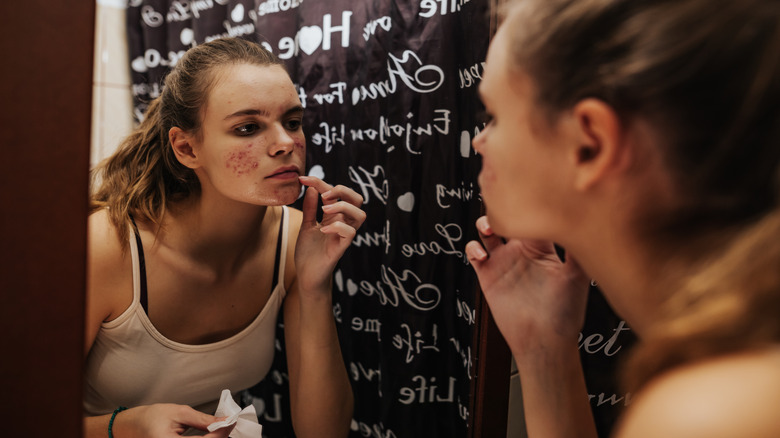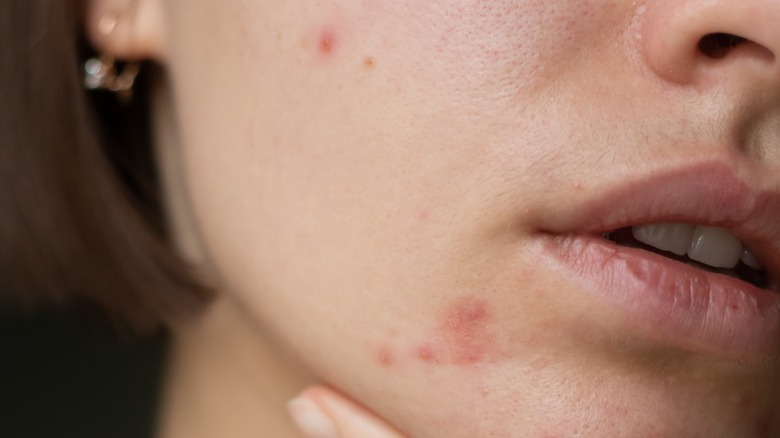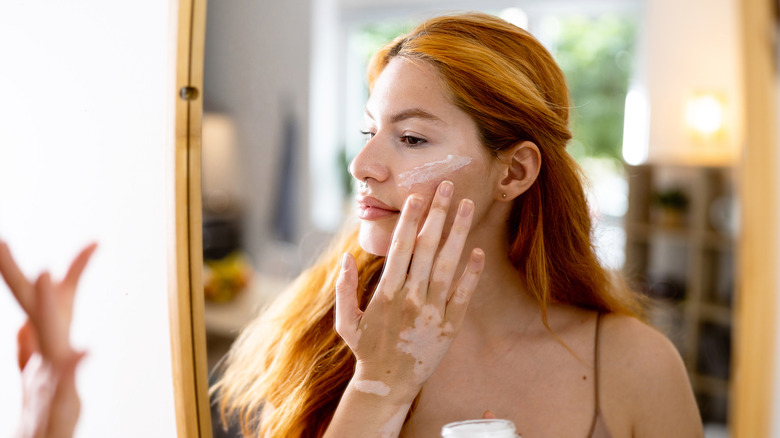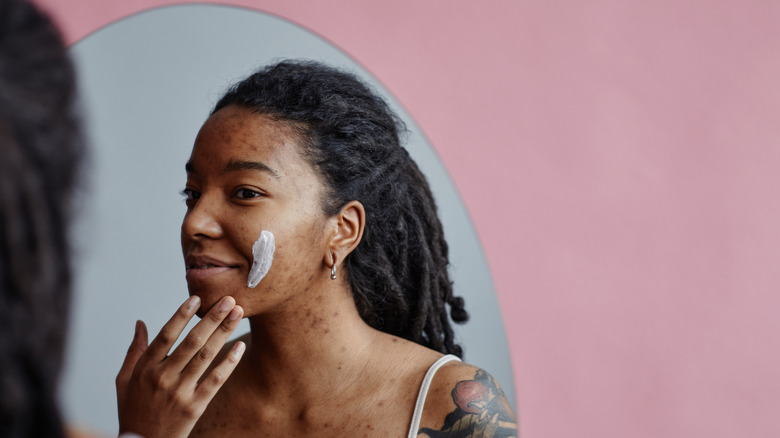Here's How To Tell If Your Skin Is Purging Or It's Just A Breakout
After adding certain ingredients to your skincare routine, you may have experienced a flare-up of redness and pimples that weren't there before. Depending on the products you use, this could mean that your skin is going through what some call the purging process. As explained by aesthetic physician Dr Ifeoma Ejikeme to British Vogue, "Skin purging occurs when a product or process speeds up the skin's cell turnover, leading to tiny open or closed comedones that usually manifest as white heads on the skin." In other words, purging is your skin pushing buildup to the surface, resulting in acne flare-ups.
According to Ejikeme, it's common to experience purging specifically after using retinoids, exfoliating acids, or chemical peels. That's because these ingredients cause dead skin cells to shed at a quicker rate than normal in order to make room for new cells. This unfortunately means that it shows up on your skin as a temporary breakout of whiteheads, blackheads, or cysts, hence why some people say that your skin will get worse before it gets better.
However, if you have naturally acne-prone skin, figuring out whether you're actually reacting to a product can be frustrating and confusing. But there are few key things to look out for that will clue you in to whether your skin is actually irritated or just adjusting to a new ingredient.
Skin purging happens where your skin is already congested
If you've heard of acne face-mapping, then you know location matters a lot when figuring out the cause of a breakout. One surefire sign you're dealing purging is if your zits pop up in spots where you tend to already breakout. "[P]urging typically brings the existing blockages within the pores to the surface," Dr. Joshua Zeichner, professor and director of cosmetic and clinical research in dermatology at Mount Sinai Hospital in New York City, told Self.
So, if you tend to break out on your chin and notice more some whiteheads appear there a week after trying a tretinoin cream, that it could be an indication the product is bringing forward the gunk that's already there. By contrast, a typical acne breakout can pop up anywhere, at any time, including normally clear areas. Zeichner added to Self that a skin purge typically consists of multiple pimples or comedones, whereas a breakout can just be a single zit or bump. So if you notice a random pimple on your forehead and nowhere else, it's less likely that your AHA serum caused it; and more likely to be the result of bacteria or some other irritant.
Pay attention to the type of products you're using
Although a temporary purging period is common when your skin adjusts to a new product, it's important to keep in mind that this isn't the case for all ingredients. A good indicator that you may be dealing with a purge rather than a reaction is if you're using an exfoliant or acne-fighting product, as these are designed to bring dead skin cells to surface. These include topical retinoids – for instance, retinol, tretinoin, and adapalene, as well as oral isotretinoin (commonly known as the brand name Accutane). Skin purging may also occur after using benzoyl peroxide, salicylic acid, and alpha hydroxy acids. However, if you're breaking out after trying something that doesn't contain these actives, it's more likely that you're experiencing an allergic or irritated reaction. Ingredients like ceramides, hyaluronic acid, vitamin C, and niacinamide shouldn't cause your skin to purge, so if you notice breakouts after starting them, you may want to talk to your dermatologist before continuing use.
Purging tends to look worse, but heal faster than regular breakouts
Time can be the biggest tell for whether you're purging or reacting to a product. Per Self, the key difference is that purging comes on strong and fast, but doesn't stick around for very long. This can look like a bunch of whiteheads that appear on your cheeks the morning after you try a new retinoid, but vanish 5 days later. A breakout, meanwhile, typically takes a full 10 days to form and disappear.
Unlike a typical breakout, blemishes formed from a skin purge will typically resolve on their own during the next skin cycle. In case you need a reminder, a skin cycle is the length of time it takes for new skin cells to form in the deeper layers of the skin and come to the skin's surface. Per Well + Good, this is estimated to take about 28 days.
Give your skin time to heal, but take note if your skin is getting worse after a few weeks. Board-certified dermatologist Dr. Sapna Palep told Byrdie, "If you start a new product known for purging, but the breakouts are lasting longer than four to six weeks, then it may signal the product is not working for you or actually making things worse."
Caring for your skin while it's purging
Though it's tempting to give up a new product after a few pimples appear, patience will do you a favor in the long run. In order for certain ingredients to penetrate your skin and make it look even, clearing out the gunk is a necessary process. For that reason, it's especially important to not be too harsh on it. This means not going heavy with other products or picking at blemishes. Try to be patient and remember that this is your skin trying to improve. Experts at Very Well Health recommend being gentle when cleansing the face and not scrubbing too hard, as this can lead to more irritation.
If the purging feels uncomfortable or painful, bring up your concerns to a dermatologist. For topical prescription retinoids like Tretinoin, some dermatologists may recommend decreasing your dosage or reducing how often you use it. Over time, as your skin adjusts to the cream, you can gradually increase the amount.




